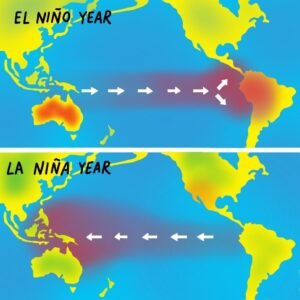Physical Address
23,24,25 & 26, 2nd Floor, Software Technology Park India, Opp: Garware Stadium,MIDC, Chikalthana, Aurangabad, Maharashtra – 431001 India
Physical Address
23,24,25 & 26, 2nd Floor, Software Technology Park India, Opp: Garware Stadium,MIDC, Chikalthana, Aurangabad, Maharashtra – 431001 India

El Niño and La Niña are natural climate phenomena that significantly impact global weather patterns and can influence climate change-related processes. While they are not direct causes of climate change, they can exacerbate its effects in various ways. Let’s consider the El Nino and La Nina process.
El Niño and La Nina
El Niño is a climate pattern that describes the unusual warming of surface waters in the eastern tropical Pacific Ocean. El Niño is the “warm phase” of a more significant phenomenon called the El Niño-Southern Oscillation (ENSO). During an El Niño, water temperatures in the Pacific Ocean may rise 3 – 5 degrees above average.
Also, La Niña, consider the “cool phase” of ENSO, is a pattern that describes the unusual cooling of the region’s surface waters. El Niño and La Niña are considered the ocean part of ENSO, while the Southern Oscillation is its atmospheric changes.
El Niño and La Niña occurrences typically last nine to 12 months but can sometimes last for years; they usually start around April and peak in intensity between November and February of the following year.
Temperature changes can lead gastro intestinal diseases!
El Niño events are associated with warmer-than-average sea surface temperatures in the central and eastern tropical Pacific Ocean. This can lead to more frequent and intense heatwaves, droughts, and wildfires in some regions influencing global warming. A warming of the central to eastern tropical Pacific Ocean, El Niño, has affected more than 60 million people, particularly in east and southern Africa, the Horn of Africa, Latin America and the Caribbean, and the Asia-Pacific region in 2015-2016. More can be read here,
At the same time, these conditions increased smoke and deteriorated air quality, causing or exacerbating respiratory diseases and heat stress. Higher temperatures can also increase gastrointestinal infections and adversely affect preterm birth rates, stillbirths, and low birth weight. El Niño-related warmer temperatures may result in vector-borne disease epidemics in highland areas, which are too cold for vector survival and disease transmission at other times.
According to the WHO situation analysis report, El Nino and La Nina are challenging to access clean water and worsen maternal and child health in general. High temperatures lead to droughts that reduce the water available for washing and sanitation and increase the disease risk.
Changes in Rainfall and associated diseases
Conversely, El Niño and La Niña can disrupt standard precipitation patterns. El Niño tends to bring heavy rainfall to some regions, leading to flooding and landslides as well La Nina can result in enhanced rain in some areas. In South East Asia, higher than-normal rainfall tends to occur during a La Niña episode, which may result in increased floods. More can be read here,
These conditions can have direct injuries and fatalities in the very first stage. Then several waterborne diseases and vector-borne diseases can occur. Cholera and diarrheal are known as central waterborne diseases. Other common illnesses linked to contaminated water supplies and flooding are typhoid fever, shigellosis, and hepatitis A and E. More can be read here; Food preparation practices may be similarly impacted. Leptospirosis is a rodent-borne disease also associated with flooding.
Health planners are used to dealing with spatial risk concepts but need to gain experience with temporal risk management. ENSO and seasonal climate forecasts might offer the opportunity to target scarce resources for epidemic control and disaster preparedness. More can be read here,
Coral Bleaching can lead to risk in protein availability.
El Niño events can lead to elevated sea surface temperatures, triggering widespread coral bleaching events. Corals expel the symbiotic algae living within their tissues when stressed by high temperatures, which can lead to coral death if the stress is prolonged. This can have devastating impacts on marine ecosystems and the biodiversity they support. Higher temperatures increase the growth of microorganisms, particularly in aquatic or marine ecosystems. Algal blooms form and some of which produce toxins that affect fish. Fish is a significant protein source since it insecure protein consumption.
Vaccine-preventable diseases
Displacement, crowding, and lack of access to vaccination are likely to increase the risk of several vaccine-preventable diseases, such as measles and meningitis. Drier than normal conditions and stronger Harmattan winds create favorable conditions for increased transmission of meningococcal meningitis.
WHO strongly recommends the implementation of active case finding in health facilities, communities, and laboratories, to increase the sensitivity of the surveillance system for measles and rubella.
Risk in Mental Health
In the context of El Niño, acute stress and exacerbations of mental health conditions likely result from Reduced livelihoods, food insecurity, displacement, and reduced access to health services.
Additionally, researchers have shown that El Niño can result in suboptimal complementary feeding practices by reducing access to food and the time mothers can spend with children increasing stress.
The critical response areas for mitigating the health effects of El Niño and La Nina
Conclusion
El Niño and La Niña can exacerbate specific climate-related impacts; their effects are temporary and typically last a few months to a few years. Health services must develop early detection and diagnosis practices for these diseases for timely response and control of transmission at the local level before they become more significant outbreaks. In contrast, human-induced climate change is a long-term phenomenon driven by the accumulation of greenhouse gases in the atmosphere from activities like burning fossil fuels. Addressing the underlying causes of climate change is essential for mitigating its more significant and lasting impacts.
If you have any queries or come across suspicious content related to climate change or the environment and want us to verify them for you, then send them to us on our WhatsApp hotline: +917045366366